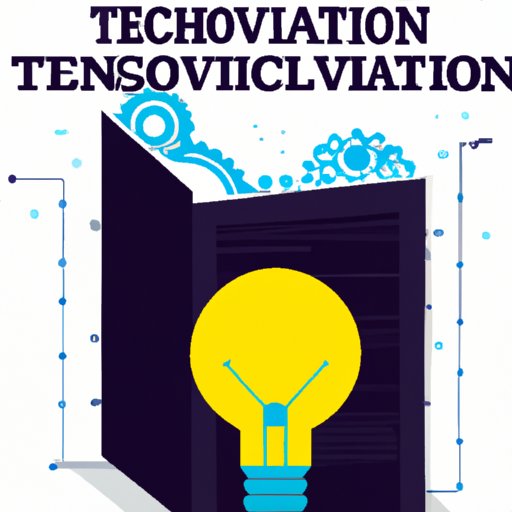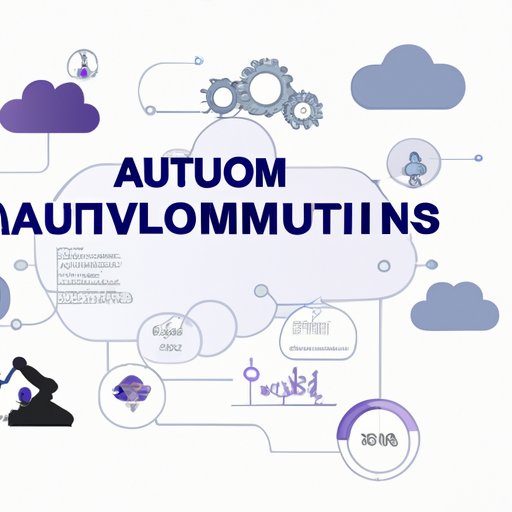Introduction
Technological innovation refers to the introduction of new products, services, processes, or business models that are based on digital technologies. It is an important factor in driving economic growth, productivity, and improving quality of life. In this article, we will explore the benefits of technological innovation, examine its timeline and current applications, provide a comprehensive guide to technological innovation, and look at the impact on society and its potential future.

Exploring the Benefits of Technological Innovation
Today’s businesses rely heavily on technology for their operations and success. As such, technological innovation has become increasingly important, as it can help organizations gain a competitive edge, reduce costs, and improve quality. Here are some of the main benefits of technological innovation:
Increased Productivity
The use of technology can greatly increase productivity by automating mundane tasks and streamlining processes. According to research conducted by McKinsey Global Institute, “the process of automation could raise productivity growth globally by 0.8 to 1.4 percent annually.” This would enable organizations to do more with less, leading to improved efficiency and cost savings.
Cost Reduction
By implementing new technologies, businesses can save money by reducing labor costs and eliminating inefficiencies. For example, cloud computing can reduce IT costs by eliminating the need for physical hardware and software, while automation can reduce the need for manual labor. Additionally, technological innovation can help reduce overhead costs, such as energy and materials, by increasing efficiency and improving resource utilization.
Improved Quality
Technology can be used to improve the quality of products and services, which can lead to increased customer satisfaction and loyalty. For instance, using automation and machine learning can lead to higher accuracy and precision, while using sensors and analytics can improve the quality of data collection and analysis.
Enhanced Efficiency
Technological innovation can help businesses become more efficient and agile by streamlining processes and eliminating redundant activities. For example, artificial intelligence (AI) can be used to automate decision-making, while cloud computing can facilitate faster communication and collaboration. Additionally, technological innovation can enable businesses to quickly adapt to changing market conditions and customer needs.
A Timeline of Technological Innovation
To better understand the role of technological innovation, let’s take a look at its history. Here is a brief overview of some of the major milestones in the development of technology:
Pre-Industrial Revolution Innovations
Throughout history, people have been innovating and creating new tools and technologies to make their lives easier. Pre-industrial revolution innovations include the invention of paper, gunpowder, and the printing press. These inventions paved the way for the industrial revolution.
The Industrial Revolution
The industrial revolution began in the late 1700s and was characterized by the adoption of new manufacturing processes and machines. Notable inventions during this era include the steam engine, spinning jenny, and telegraph. These inventions allowed for mass production and facilitated global communication.
The Digital Revolution
In the late 20th century, the world entered the digital age, with the introduction of computers and the internet. This period saw the emergence of new technologies, such as the World Wide Web, mobile phones, and social media. These innovations enabled businesses to reach new markets and customers, and ushered in the era of globalization.
How Technological Innovation is Revolutionizing Industries
Today, technological innovation is transforming almost every industry, from retail and hospitality to healthcare and finance. Here are some of the most significant advances in technology that are revolutionizing the way businesses operate:
Automation and Robotics
The use of robots and automated systems is becoming increasingly popular in many industries, as they can help reduce costs, increase efficiency, and improve safety. For instance, robots are being used in manufacturing to automate repetitive tasks, and in healthcare to assist with surgeries and diagnostic procedures.
Artificial Intelligence
AI is being used in many industries, from finance to logistics, to automate decision-making and improve accuracy. AI-powered algorithms can also be used to analyze large amounts of data and identify patterns that would otherwise be too complex for humans to detect.
Cloud Computing
Cloud computing has revolutionized the way businesses store and access data. By utilizing cloud storage, businesses can access their data from any device and location, enabling them to collaborate more effectively and scale up quickly.
Big Data Analytics
Big data analytics provides businesses with insights into customer behavior, trends, and preferences. By analyzing large amounts of data, businesses can gain valuable insights into their customers’ needs and develop strategies to better meet those needs.

A Comprehensive Guide to Technological Innovation
Implementing new technologies can seem daunting at first, but the right approach can make the process much smoother. Here is a comprehensive guide to help you get started:
Identifying Opportunities
The first step is to identify opportunities for improvement within your organization. This can be done by examining current processes and identifying areas where technology can be used to simplify or automate tasks. It is also important to consider the costs associated with any proposed changes.
Developing an Innovation Strategy
Once opportunities have been identified, it is important to develop a clear strategy for how to implement new technologies. This should involve setting objectives and priorities, as well as determining which technologies are best suited to meeting those objectives.
Implementing New Technologies
Once a strategy has been developed, the next step is to implement the new technologies. This may involve training staff on the new systems, making sure the technology is properly integrated into existing processes, and ensuring that all data is secure.
Evaluating Results
Finally, it is important to evaluate the results of the implementation. This can be done by measuring key performance indicators, such as cost savings, productivity gains, and customer satisfaction. This will help you determine whether the new technology is meeting your objectives.
Examining the Impact of Technological Innovation on Society
Technological innovation has had a profound impact on society, from enhancing education to improving healthcare. Here are some of the ways that technology is transforming our lives:
Enhancing Education
Technology has revolutionized the way we learn. From online courses to virtual classrooms, technology is making education more accessible and interactive. Additionally, AI-powered tutoring systems can help students learn more effectively, while 3D printing can make science and engineering concepts easier to understand.
Increasing Accessibility
Technology has enabled us to access information and services from virtually anywhere. For instance, mobile devices allow us to stay connected to our family and friends, while online shopping makes it easier to buy the things we need. Additionally, advancements in medical technology are helping to improve access to healthcare for underserved populations.
Improving Healthcare
Technological innovation has had a huge impact on healthcare. From electronic health records to telemedicine, technology is making healthcare more efficient and effective. Additionally, AI and machine learning are being used to diagnose diseases and develop personalized treatments.
Transforming Transportation
Advances in technology are revolutionizing the way we get around. Autonomous vehicles are becoming increasingly common, while ride-sharing services are making public transportation more accessible. Additionally, drones are being used to deliver packages, and vehicle-to-vehicle communication is making roads safer.

Exploring the Future of Technological Innovation
Looking ahead, technological innovation is set to continue to have a transformative effect on society. Here are some of the technologies that are likely to shape the future:
Advances in Automation
Advances in robotics and automation will continue to make life easier, from self-driving cars to automated factories. Additionally, smart homes and cities will become more commonplace, as technology is used to improve efficiency and reduce waste.
Augmented Reality & Virtual Reality
Augmented reality (AR) and virtual reality (VR) will become increasingly common, as they are used to create immersive experiences. For instance, AR can be used to overlay information on real-world objects, while VR can be used to simulate different environments.
Blockchain Technology
Blockchain technology is set to revolutionize many industries, from finance to healthcare. By providing a secure and transparent ledger of transactions, blockchain can help eliminate fraud and reduce costs. Additionally, blockchain can be used to store data securely and facilitate faster payments.
Autonomous Vehicles
Autonomous vehicles are already beginning to change the way we get around. By eliminating human error, autonomous vehicles can improve safety and reduce traffic congestion. Additionally, these vehicles can be used to transport goods quickly and efficiently.
Conclusion
In conclusion, technological innovation has the potential to revolutionize the way we live and work. It can increase productivity, reduce costs, improve quality, and enhance efficiency. Additionally, it can be used to improve accessibility, transform transportation, and revolutionize industries. Finally, looking ahead, advances in automation, augmented reality, blockchain technology, and autonomous vehicles are set to shape the future.
(Note: Is this article not meeting your expectations? Do you have knowledge or insights to share? Unlock new opportunities and expand your reach by joining our authors team. Click Registration to join us and share your expertise with our readers.)
